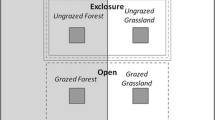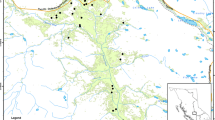Abstract
Old field succession in Oklahoma has been reported to involve four stages of development: pioncer weeds, annual grass, bunch grass, and mature prairie. This sequence has been the basis for a number of analyses of grassland structure and function, but has never been documented on a single site. We used multivariate techniques to study succession on three permanent plots with different initial plowing treatments in a central Oklahoma grassland. Only two of the four hypothesized stages could be identified: pioneer weeds and mature prairie. The intervening vegetation development was heterogeneous and unpredictable. Convergence was evident in only a general manner in that all plots are currently being invaded by shrubs and some tree species. Thus, succession on these plots has advanced beyond prairie to shrub-grassland and we predict that upland forest trees may eventually dominate the site. Succession from pioneer weeds beyond prairie to shrub-grassland has been very rapid. Fire suppression may have contributed to these rapid vegetation changes. Finally, no trends in diversity, evenness, or total number of species were evident during succession.
Similar content being viewed by others
References
Abrell, D. B. & Jackson, M. T., 1977. A decade of change in an old-growth beech-maple forest in Indiana. Amer. Midl. Nat. 98: 22–32.
Adams, D. E., Anderson, R. C. & Collins, S. L., 1982. Differential response of woody and herbaceous species to summer and winter burning in an Oklahoma grassland. Southwest. Nat. 27: 55–61.
Alatalo, R. V., 1981. Problems in the measurement of evenness in ecology. Oikos 37: 199–204.
Anderson, J. E. & Holte, K. E., 1981. Vegetation development over 25 years without grazing on sagebrush-dominated rangeland in southeastern Idaho. J. Range Manage. 34: 25–29.
Austin, M. P., 1977. Use of ordination and other multivariate deseriptive methods to study succession. Vegetatio 35: 165–175.
Beeftink, W. G., 1979. Vegetation dynamics in retrospect and prospect. Introduction to the proceedings of the second symposium of the working group on succession on permanent plots. Vegetatio 40: 101–105.
Booth, W. E., 1941. Revegetation of abandoned fields in Kansas and Oklahoma. Amer. J. Bot. 28: 415–422.
Brady, N. C., 1974. The nature and properties of soils. MacMillan Publ, Co., Inc. New York, 639 pp.
Bragg, T. B. & Hulbert, L. C., 1976. Woody plant invasion of unburned Kansas bluestem prairie. J. Range Manage. 29: 19–24.
Bruner, W. E., 1931. The vegetation of Oklahoma. Ecol. Monogr. 1: 101–188.
Christensen, N. L., 1977. Changes in structure, pattern and diversity associated with climax forest maturation in Piedmont, North Carolina. Amer. Midl. Nat. 97: 176–188.
Collins, S. L., Risser, P. G. & Rice, E. L., 1981. Ordination and classification of mature bottomland forests in north-central Oklahoma. Bull. Torrey Bot. Club 108: 152–165.
Dale, M. B. & Clifford, H. T., 1976. On the effectiveness of higher taxonomic ranks for vegetation analysis. Austral. J. Ecol 1: 37–62.
Daubenmire, R., 1968. Ecology of fire in grasslands. Advan. Ecol. Res. 5: 200–266.
Gauch, H. G., Whittaker, R. H. & Wentworth, T. R., 1977. A comparative study of reciprocal averaging and other ordination techniques. J. Ecol. 65: 157–174.
Glenn-Lewin, D. C., 1980. The individualistic nature of plant community development. Vegetatio 43: 141–146.
Goff, F. G. & Zedler, P. H., 1972. Derivation of species succession vectors. Am. Midl. Nat. 87: 397–412.
Gould, F. W., 1975. The grasses of Texas. Texas A and M. Univ. Press, College Station, TX, 653 pp.
Hill, M. O., 1973. Reciprocal averaging: an eigenvector method of ordination. J. Ecol. 61: 237–249.
Kaputska, L. A. & Moleski, F. L., 1976. Changes in community structure in Oklahoma old field succession. Bot. Gaz. 137: 7–10.
Keeley, S. C., Keeley, J. E., Hutchinson, S. M. & Johnson, A. W., 1981. Postfire succession of the herbaceous flora in southern California chaparral. Ecology 62: 1608–1621.
Kelting, R. W., 1954. Effects of moderate grazing on the composition and plant production of a native tallgrass prairie in central Oklahoma. Ecology 35: 200–207.
Kucera, C. L., 1981. Grasslands and fire. In: H. A. Mooney et al. (eds.). Fire regimes and ecosystem properties, p. 90–111. U.S.D.A. For. Serv. Gen. Tech. Rep. WO-26, 594 pp.
Little, S., 1973. Eighteen year changes in the composition of a stand of Pinus echinata and Pinus rigida in southern New Jersey. Bull. Torrey Bot. Club 100: 94–102.
Little, S. & Escheman, R. T., 1976. Nineteen year changes in the composition of a stand of Pinus taeds in eastern Maryland. Bull. Torrey Bot. Club 103: 57–66.
Maarel, E. van der, 1972. Ordination of plant communities on the basis of their plant genus, family, and order relationships. In: E. van der Maarel and R. Tuxen (eds.). Grundfragen und Methoden in der Pflanzensoziologie, pp. 183–192. Junk Pubi., The Hague.
Maarel, E. van der & Werger, M. J. A., 1978. On the treatment of succession data. Phytocoenosis 7: 257–278.
Matthews, J. A., 1979. A study of the variability of some successional and climax plant assemblage-types using multiple diseriminant analysis. J. Ecol 67: 255–272.
McIntosh, R. P., 1980. The relationship between succession and the recovery process in ecosystems. In: J. Cairns (ed). The recovery process in damaged ecosystems. pp. 11–62. Ann Arbor Science, Inc. Ann Arbor, MI, 167 pp.
Moral, R. del, 1975. Vegetation elustering by means of ISODA-A: revision by multiple discriminant analysis. Vegetatio 29: 179–190.
Moral, R. del, 1980. On selecting indirect ordination methods. Vegetatio 42: 75–84.
Morel, R. del & Denton, M. F., 1977. Analysis and classification of vegetation based on family composition. Vegetatio 34: 155–165.
Moral, R. del & Watson, A. F., 1978. Gradient structure of forest vegetation in the central Washington Cascades. Vegetatio 38: 29–48.
Peet, R. K., 1974. The measurement of species diversity. Ann. Rev. Ecol. Syst. 5: 285–307.
Peet, R. K. & Christensen, N. L., 1980. Succession: a population process. Vegetatio 43: 131–140.
Penfound, W. T., 1964. The relation of grazing to plant succession in the tall grass prairie. J. Range Manage. 17: 256–260.
Penfound, W. T. & Rice, E. L., 1957a. Plant population changes in a native prairie plot plowed annually over a five-year period. Ecology 38: 148–150.
Penfound, W. T. & Rice, E. L., 1957b. Effects of feneing and plowing on plant succession in a revegetating field. J. Range Manage. 10: 21–22.
Perino, J. V. & Risser, P. G., 1972. Some aspects of structure and function in Oklahoma old field succession. Bull. Torrey Bot Club 99: 233–239.
Petranka, J. W. & McPherson, J. K., 1979. The role of Rhus copallina in the dynamics of the forest-prairie ecotone in north-central Oklahoma. Ecology 60: 956–965.
Puhr, L. F. & Olson, O., 1937. A preliminary study of the effect of cultivation on certain chemical and physical properties of some South Dakota soils. South Dakota State College Agric. Exp. Sta. Bull. 314, 31. pp.
Rice, E. L., 1974. Allelopathy, Academic Press, New York, NY. 368 pp.
Rice, E. L. & Penfound, W. T., 1959. The upland forests of Oklahoma. Ecology 40: 593–608.
Risser, P. G. & Rice, E. L., 1971. Phytosociological analysis of Oklahoma upland forest species. Ecology 52: 940–945.
Schmidt, W., 1975. Sukzessionsforschung. Ber. Symp. Intern. Ver. Vegetationskunde 1973, Cramer, Vaduz, 622 pp.
Schwintzer, C. & Williams, G., 1975. Vegetation changes in a small Michigan bog from 1917–1972. Amer. Midl. Nat. 92: 447–459.
Shugart, H. H., West, D. C. & Emanuel, W. R., 1981. Patterns and dynamics of forests: an application of simulation models. In: D. C. West, H. H. Shugart & D. B. Botkin (eds). Forest succession: concepts and application, pp. 74–94. Springer-Verlag, New York, NY, 517 pp.
Sneath, P. H. A. & Sokal, R. R., 1973. Numerical taxonomy, W. H. Freeman and Co., San Francisco, Calif., 573 pp.
Vogl, R. J., 1974. Effects of fire on grasslands. In: T. T. Kozlowski & C. E. Ahlgren (eds). Fire and ecosystem, p. 139–194. Academic Press, New York, NY, 542 pp.
Waterfall, U. T., 1972. Keys to the flora of Oklahoma. 5th ed. Oklahoma State Univ., Stillwater, OK, 246 pp.
Whittaker, R. H. & Levin, S. A., 1977. The role of mosaic phenomena in natural communities. Theoret. Pop. Biol. 12: 117–139.
Author information
Authors and Affiliations
Additional information
Nomenclature follows Gould(1975) for grasses and Waterfall (1972) for other plants.
The authors would like to thank Dr. Elroy Rice for providing data from earlier samples. We thank Susan Barber for help with the 1981–1982 samples. Roger Anderson, Karen Dooley, Robert Peet, Elroy Rice. Paul Risser, Linda Wallace, and two anonymous reviewers provided many helpful comments on earlier versions of the manuscript.
Rights and permissions
About this article
Cite this article
Collins, S.L., Adams, D.E. Succession in grasslands: Thirty-two years of change in a central Oklahoma tallgrass prairie. Vegetatio 51, 181–190 (1983). https://doi.org/10.1007/BF00129437
Accepted:
Issue Date:
DOI: https://doi.org/10.1007/BF00129437




